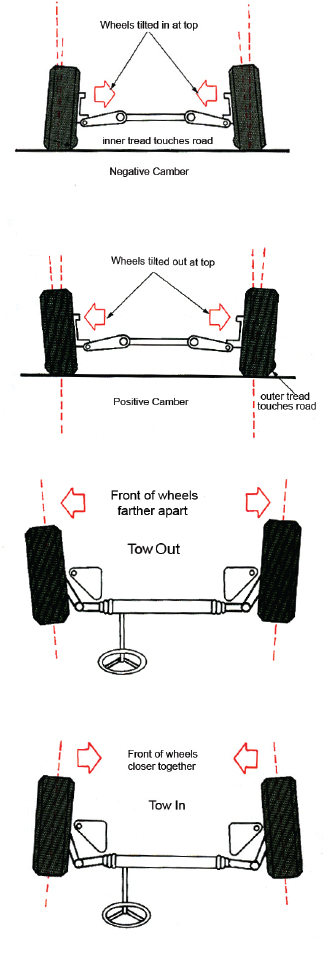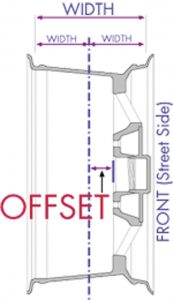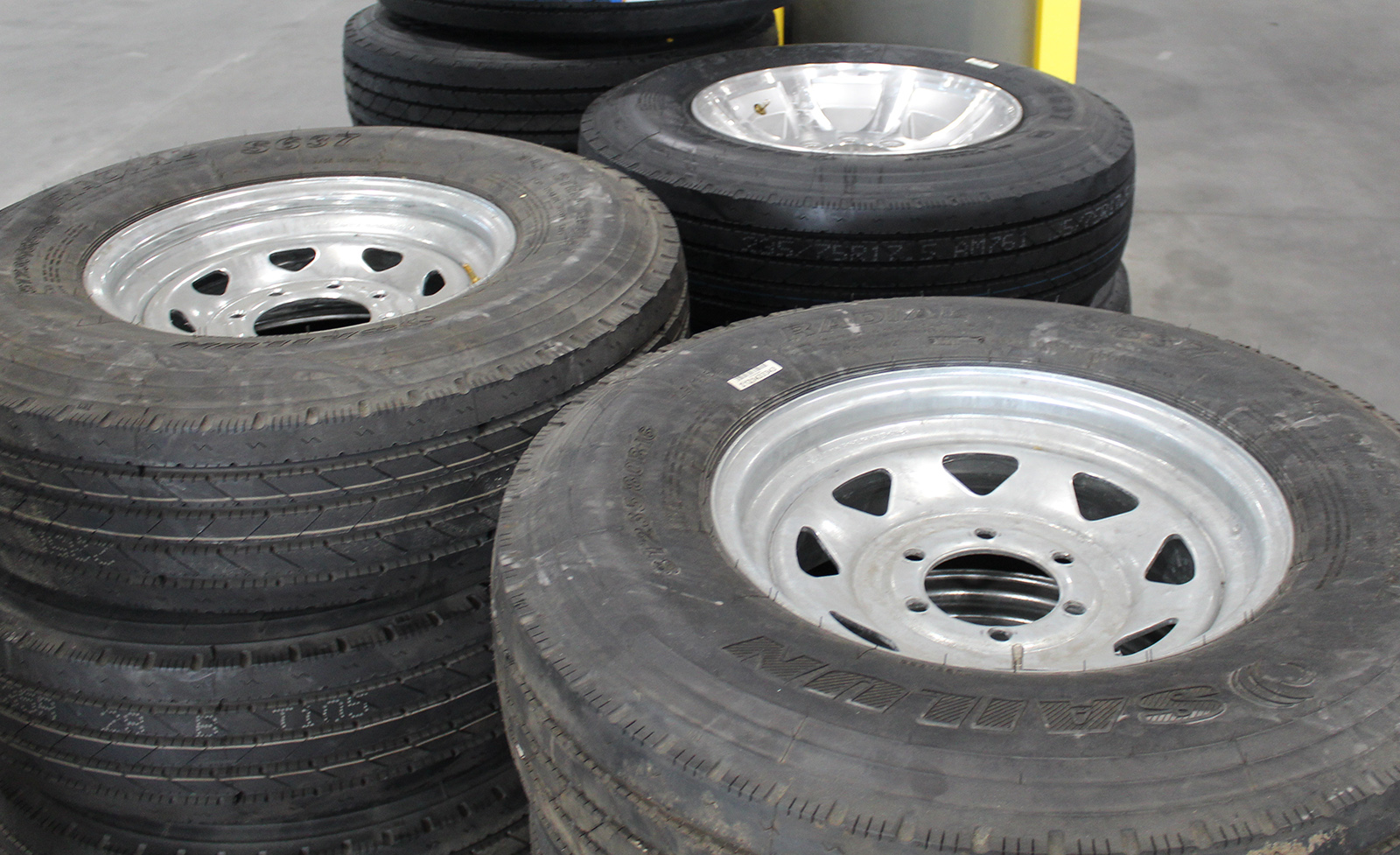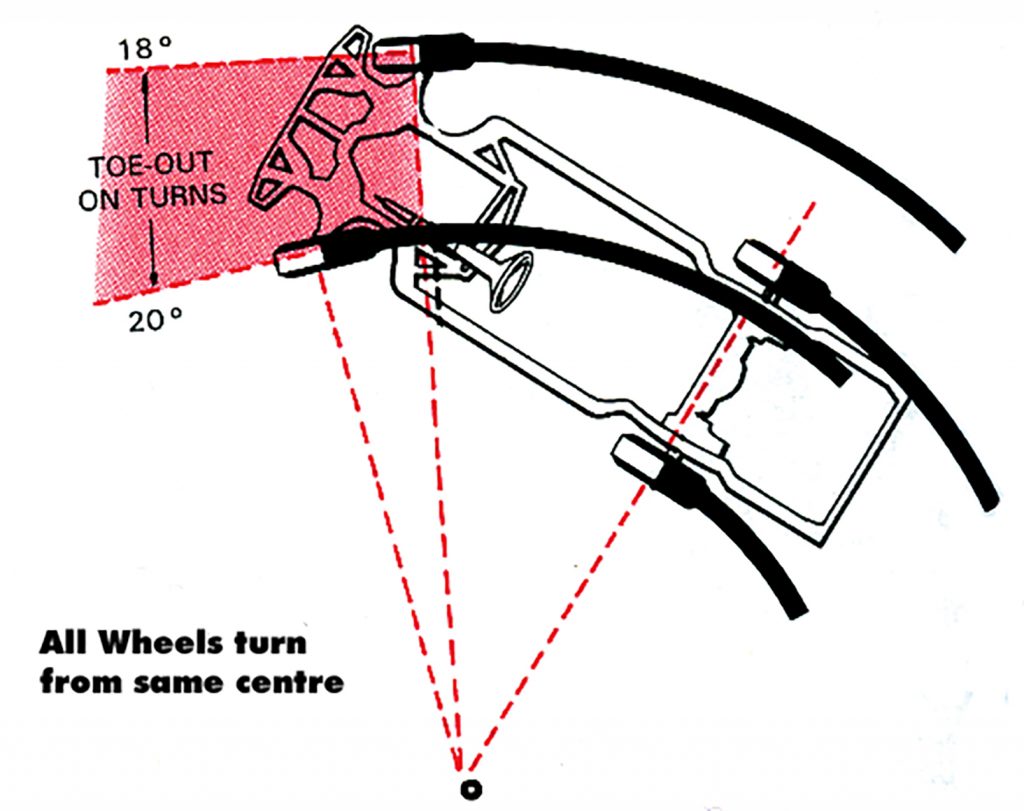Keeping an eye on the rubber helps prevent problems on the road!
By Garth Cane
The most important point with tires on our tow vehicle or trailer is to have proper inflation for the load that we are carrying. If we have too much load or the tires are under inflated, the sidewalls will flex a great deal more than necessary and the tire will overheat. Tires are molded at a temperature of 300 degrees Fahrenheit, so if the temperature of your tires gets that high, they will disintegrate. With recommended inflation pressures your tires will usually run about thirty degrees hotter than the ambient temperature of the day. Driving fast on a hot day is not good for your tires.
The only way to know the proper inflation is to weigh the tow vehicle and trailer when it is loaded for a trip. You need to know the weight on each individual wheel and then go to the published inflation charts provided by the tire manufacturers. Since many of our vehicles and trailers can be heavier on one side than the other, I always inflate both tires on the same axle for the inflation needed by the heavier side. Michelin recommends driving your trailer over a scale with just the front tires on at first.
Mark down the reading, then pull forward to get a reading of the weight on the rear axle only. The next time you come to a scale, move over to the left so that only the tires on the right side are on the scale. Deduct these figures from the first set, then you can go to the inflation charts. Now you know the weight on each individual wheel. The charts for your own tires are available from your friendly tire dealer or from the Michelin or Goodyear websites. Once you have downloaded the charts look at the figures for your tire brand and size. You will now be able to see the proper inflation for your tires to carry the weight.

The tires on our tow vehicles, and trailers often show signs of misalignment as the tires wear unevenly, and we sometimes have tracking problems where the trailer does not follow in the same path as the tow vehicle. When the tires are not aligned properly, we often get abnormal wear as the rubber tread is scrubbed off unevenly. Tires are designed to lose a certain amount of rubber as they move over the rough surface of the road. Depending on the design of the tire, they may have a softer compound to get a firmer grip on the surface or a harder compound to promote longer life. Wheels must be parallel to each other and perpendicular to the ground, thus maximizing tire life and ensuring straight and true tracking along a straight and level road.
The front steering tires of our tow vehicles often show the most effects of poor alignment as tread can be scrubbed off in normal turns when one tire is going in a slightly different path than the other one. Tires on rear drive wheels show wear from skidding on the surface as they provide the traction needed to move our vehicle ahead. But the rear tires on a front wheel drive vehicle or travel trailer do not show the wear as much since they normally follow straight in line with the direction of travel and the wheels are not providing driving power that can scrub the rubber off the tread as the trailer moves ahead.
When tires are not all moving in the same direction, heat is developed from friction as the tread scrubs against the surface of the road. When the axle of the trailer is out of alignment, the wheels on one side are being dragged down the road overheating and losing tread. This results in tire failure over a short period of time.

Tire alignment is set at the factory but can sometimes be thrown off by changing to different tires or wheel rims, hitting tough potholes, curbs, or in accidents.
Tandem axle trailers often have a set of two springs, one set for each axle. When the trailer hits a bump, the tire goes up forcing the axle to move slightly. If the bump is excessive, the u-bolt holding the axle on the spring can move and place the axle out of alignment. To ensure proper tracking, the axle must be perpendicular to the center line of the vehicle. In multiple axle configurations, each axle must be parallel with the other within 1/16 of an inch when measured at the wheel centers.
 Camber settings prevent wear on the inner and outer tread of the tire and load the larger inner wheel bearing. This aids steering by placing the vehicle weight on the inner end of the spindle. Most vehicle manufacturers suggest a slightly positive camber setting (about 1/4 to ½ degree) this counteracts the effect of overloading on a vehicle. Camber can also be affected when the springs sag and cause the ride height to change.
Camber settings prevent wear on the inner and outer tread of the tire and load the larger inner wheel bearing. This aids steering by placing the vehicle weight on the inner end of the spindle. Most vehicle manufacturers suggest a slightly positive camber setting (about 1/4 to ½ degree) this counteracts the effect of overloading on a vehicle. Camber can also be affected when the springs sag and cause the ride height to change.
When wheels with the wrong offset are mounted on the axles, the load is transferred unequally to the inner and outer bearings of the axle spindle, causing failure of the axle. The offset of a wheel is the distance from its hub mounting surface to the centerline of the wheel. If the hub mounting surface is even with the centerline of the wheel, it has zero offset. Deep-dish wheels where the hub mounting surface is towards the brake side of the wheel have a negative offset. If the offset is not correct for the truck or trailer, handling can be adversely affected.
Tow-in or tow-out is determined by the distance between the front and rear of the left- and right-hand wheels. This controls whether the wheels roll in the same direction. It is very critical to tire wear. If the adjustment is not correct, the tires will scuff or skid sideways. Rear wheel drive vehicles usually have toe-in at the front wheels, as they tend to tow-out when driving. This is needed to compensate for the action of rolling resistance, play in the steering, and suspension system action. If the toe setting is just 1/32-inch off its appropriate setting, each tire on that axle will scrub almost 3 ½ feet sideways every mile, therefore reducing tire life.
If your tires are developing what looks like a scallop pattern on the edges, your shock absorbers have probably stopped doing their job of keeping the rubber on the road. Without shock absorbers your truck would continue to bounce up and down after striking a dip or hump in the road. Shock absorbers are designed to push the tire down so that it stays in contact with the road. If the tire bounces up away from the surface, it will slow down momentarily, and when it returns to the surface, the difference in road speed will scrub off a small amount of rubber. The more times that the tire bounces, the greater the tread damage will occur.
Changing the tires will not correct the scalloping – change the shock absorbers and then change the tires. The shock absorbers are filled with an oil to prevent a piston from moving too freely as the vehicle bounces up and down. When the body of the vehicle goes up, the piston forces against a chamber filled with oil. Then when the body goes back down, the oil must return to the other side of the piston. Gas charged shock absorbers have a low-pressure gas to prevent the oil in the shock from foaming.
Tires on boat trailers often do not move for six months or more. If they are not rotating, the natural oils in the tire are not migrating to the surface to keep them flexible. Any oils that do come to the surface may be drying out from exposure to the sun and ozone in the air. Many people in southern climates where it is hot, cover their tires to protect them. In Canada, in the winter, the sun is at a low angle where it does not produce a lot of heat and radiation.
I always check the tires for cracks in the sidewalls every year, and especially after five years. Then replace them after seven years no matter how good they look. It is not worth a blowout that could take your life for the cost of a set of tires. The date the tire was built is stamped on the sidewall of the tire. Look for the code that starts with the letters “DOT” and read the numbers that follow. (Example DOT B6 YB 2FC X 0923) The last four numbers tell you that the tire was molded in the factory on the 23rd week of 2009.




